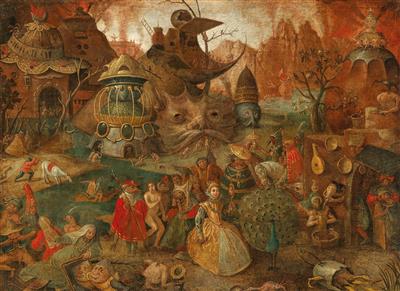Follower of Pieter Brueghel I

An Allegory of Superbia,
oil on canvas, 86 x 117 cm, framed
The present painting is based on a series of seven etchings by Pieter van der Heyden after designs by Pieter Brueghel I, published in Antwerp by Hieronymus Cock in 1556-57, known as The Seven Capital Sins.
An Allegory of Envy, with the same measurements and on canvas, was sold at Dorotheum, Vienna, 23 October 2018, lot 126.
Following his return from Rome, the series established Brueghel’s fame as the heir to Hieronymus Bosch (circa 1450–1516), and are also considered among van der Heyden’s finest works. The canonization of sins was codified in the sixth century by Pope Gregory the Great consisting of Superbia, Ira, Invidia, Avaritia, Acedia, Gula and Luxuria, and the theological discourse over sins intensified during the Reformation, providing the right market conditions among both Protestants and Catholics for Cock to commission such an ambitious series. An innovation of Brueghel was to offset the Boschian demonic forms and outlandish architecture with genre-like scenes that evoked life in mid-sixteenth century Flanders.
In the present work of Superbia, or pride, the man trying to force his mule in the background would have been a familiar scene in the streets of Antwerp. Similarly a contemporary viewer would have attached a meaning to the activities in the barbershop on the right of the present composition, in relation to the sin depicted. The narrative is also developed by Brueghel using the inscriptions, which encourages the erudite beholder to look more closely. Brueghel, whose humanist aspirations led him to drop the ‘h’ from his surname, may have worked with Dirck Volckertsz. Coornhert, considered the father of Dutch Renaissance scholarship, in devising the Latin inscriptions. Studying the central figure of the lady, attended by her peacock (Brueghel uses a central, allegorical woman embodying the sin in each of the series), if one considers the inscription ‘EMO SVPERBVS AMAT SVPEROS, NEC AMATVR AB ILLIS’ or “No one with pride loves the heavenly, and vice versa” it becomes clear that she is bound for damnation.
Expert: Damian Brenninkmeyer
 Damian Brenninkmeyer
Damian Brenninkmeyer
+43 1 515 60 403
oldmasters@dorotheum.com
10.11.2020 - 16:00
- Dosažená cena: **
-
EUR 237.540,-
- Odhadní cena:
-
EUR 40.000,- do EUR 60.000,-
Follower of Pieter Brueghel I
An Allegory of Superbia,
oil on canvas, 86 x 117 cm, framed
The present painting is based on a series of seven etchings by Pieter van der Heyden after designs by Pieter Brueghel I, published in Antwerp by Hieronymus Cock in 1556-57, known as The Seven Capital Sins.
An Allegory of Envy, with the same measurements and on canvas, was sold at Dorotheum, Vienna, 23 October 2018, lot 126.
Following his return from Rome, the series established Brueghel’s fame as the heir to Hieronymus Bosch (circa 1450–1516), and are also considered among van der Heyden’s finest works. The canonization of sins was codified in the sixth century by Pope Gregory the Great consisting of Superbia, Ira, Invidia, Avaritia, Acedia, Gula and Luxuria, and the theological discourse over sins intensified during the Reformation, providing the right market conditions among both Protestants and Catholics for Cock to commission such an ambitious series. An innovation of Brueghel was to offset the Boschian demonic forms and outlandish architecture with genre-like scenes that evoked life in mid-sixteenth century Flanders.
In the present work of Superbia, or pride, the man trying to force his mule in the background would have been a familiar scene in the streets of Antwerp. Similarly a contemporary viewer would have attached a meaning to the activities in the barbershop on the right of the present composition, in relation to the sin depicted. The narrative is also developed by Brueghel using the inscriptions, which encourages the erudite beholder to look more closely. Brueghel, whose humanist aspirations led him to drop the ‘h’ from his surname, may have worked with Dirck Volckertsz. Coornhert, considered the father of Dutch Renaissance scholarship, in devising the Latin inscriptions. Studying the central figure of the lady, attended by her peacock (Brueghel uses a central, allegorical woman embodying the sin in each of the series), if one considers the inscription ‘EMO SVPERBVS AMAT SVPEROS, NEC AMATVR AB ILLIS’ or “No one with pride loves the heavenly, and vice versa” it becomes clear that she is bound for damnation.
Expert: Damian Brenninkmeyer
 Damian Brenninkmeyer
Damian Brenninkmeyer
+43 1 515 60 403
oldmasters@dorotheum.com
|
Horká linka kupujících
Po-Pá: 10.00 - 17.00
old.masters@dorotheum.at +43 1 515 60 403 |
| Aukce: | Obrazy starých mistrů |
| Typ aukce: | Sálová aukce s Live bidding |
| Datum: | 10.11.2020 - 16:00 |
| Místo konání aukce: | Wien | Palais Dorotheum |
| Prohlídka: | 04.11. - 10.11.2020 |
** Kupní cena vč. poplatku kupujícího a DPH
Není již možné podávat příkazy ke koupi přes internet. Aukce se právě připravuje resp. byla již uskutečněna.
Všechny objekty umělce
